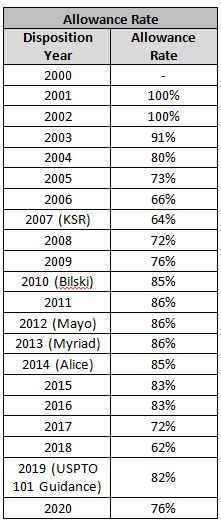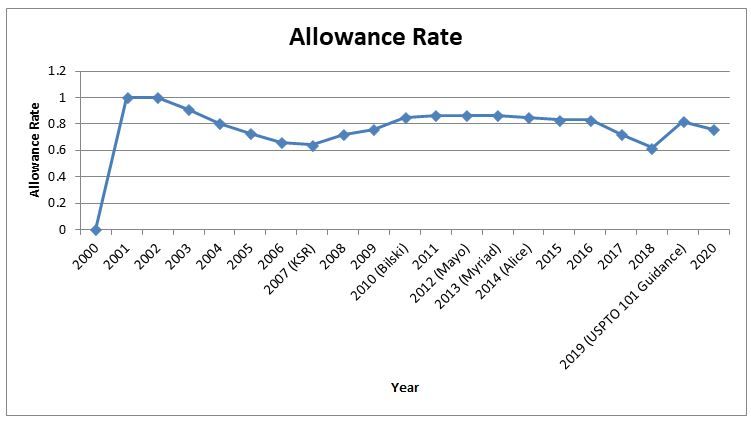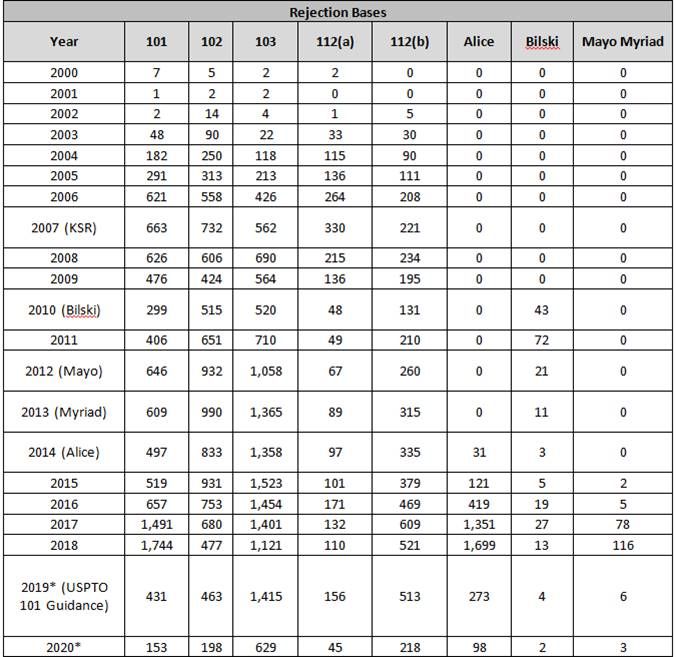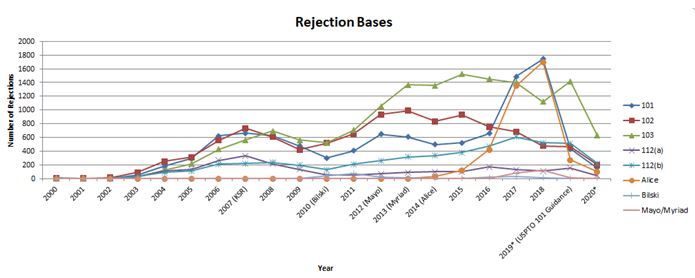Following last week's post on this blog (AI Patent Trends in the U.S. Patent Office: Is the U.S. Losing Its Lead?), we look deeper into the filing data of AI applications to better understand how the USPTO's treatment of inventions in this field have evolved over time. AI applications are increasing rapidly, but what happens when these applications get into substantive prosecution? Patent practitioners who understand this information can better help their clients avoid some of the pitfalls present, potentially resulting in higher allowance rates and less office actions to disposition. The data presented throughout this post was compiled using Juristat and focuses on the USPTO's Art Units which handle the greatest number of AI filings (2122, 2129, 2121, 2124, 2123, 2128, 2127), further filtered by USPC 706, which relates to "Data Processing - Artificial Intelligence."
Data shows that since at least 2001 (as far back as Juristat's data goes) the average allowance rate for AI filings sits at 80%, which is slightly higher than USPTO's overall allowance rate of 75%. However, as shown in Table I and Figure I, reproduced below, the allowance rate of AI applications has experienced a few notable peaks and dips. Most notably, applicants saw their lowest allowance rate in 2018, at a mere 62%. This low point in 2018 was the culmination of declining allowance rates, following the Supreme Court's 2014 decision in Alice Corp. Pty. Ltd. v. CLS Bank Int'l, 573 U.S. 208 (2014). The low point in 2018 has since recovered significantly, no doubt in large part due to the USPTO's January 2019 issuance of Patent Subject Matter Eligibility Guidance ("2019 PEG"), which marked a shift in the USPTO's review process, generally leading to increased allowance of patent applications facing scrutiny over subject matter eligibility.
Table 1

Figure 2

Rejections based on § 101 and Alice reach a peak in 2018, the same year that the USPTO had its lowest AI allowance rate of 62%. As anticipated, these § 101 rejections rapidly increased after the Supreme Court's Alice decision in 2014, but that should come as no surprise, as AI drafted claims can often fit the bill for the "abstract idea" classification that the Supreme Court was concerned about in its Alice decision. Importantly though, the graphics also show how major of an impact the USPTO's 2019 Patent Subject Matter Eligibility Guidance had at curtailing § 101 rejections, with the overall number of § 101 rejections sharply declining in 2019.
Also noteworthy is the number of obviousness (§ 103) rejections over time. The Supreme Court's decision in KSR Int'l Co. v. Teleflex Inc., 550 U.S. 398 (2007) rejected the Federal Circuit's rigid application of the Teaching-Suggestion-Motivation (TSM) test, in light of the much more flexible Graham factors. Potentially, as a result of KSR, obviousness rejections increased over time, and have accounted for the greatest number of rejections since 2010, with the exception of 2017 and 2018 when § 101 rejections lead the way. However, since the sharp decline in the number of § 101 rejections in 2019, obviousness rejections now far outpace the next most common basis of rejection (anticipation under § 102). With the § 101 inquiry now in a much more ascertainable place, obviousness rejections should be expected to continue as the most common basis of rejection for AI related applications. This is consistent with rejection bases across the USPTO as a whole. Since KSR, § 103 rejections have far exceeded all other rejection bases at the USPTO.
Table 2

Figure 2

As AI filings continue to increase, USPTO policy and procedure for handling these applications will continue to evolve. Understanding the issues and trends present when prosecuting AItechnologies at the USPTO can provide patent practitioners with a tremendous advantage. Getting applications to allowance in shorter timeframes, will reduce a company's budget and help them secure their stake in a rapidly expanding field. If AI inventors can get out of the woods of the uncertainly caused by Alice, patent prosecution in the next decade of data can be less focused on patent eligibility, and more focused on the traditional bars to patentability, such as §§ 102, 103 and 112.
The content of this article is intended to provide a general guide to the subject matter. Specialist advice should be sought about your specific circumstances.

